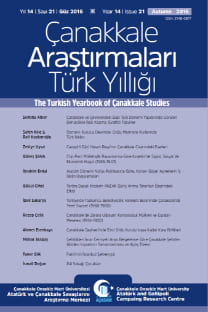Silifke Arkeoloji Müzesi’nden Bir Grup Bizans Kurşun Mühürü
Bu makalede Silifke Arkeoloji Müzesi koleksiyonunda yer alan, MS 6.-11. yüzyıllara tarihlenen yayımlanmamış yirmi altı Bizans kurşun mührü ele alınmaktadır. Müze koleksiyonunda elli civarında mühür bulunmaktadır. Çalışma dışında bırakılan mühürlerin yakın zamanda yayımlanması planlanmaktadır. Silifke Müzesi koleksiyonu, coğrafi olarak bulunduğu alanı büyük ölçüde yansıtmaktadır. Mühürlerinin tarihlenmesi, mühürlerdeki görev ve unvanların niteliği, Seleukeia’nın 6.-11. yüzyıllardaki tarihiyle uyum içindedir. Bu çalışmayla, Bizans prosopografyasına eklenecek bölgeye ait yeni isim ve ünvanlar belirmiştir.
A Group of Byzantine Lead Seals in Silifke Archaeological Museum
This article examines twenty six unpublished Byzantine lead seals in the Silifke Archaeology Museum dated to 6.-11. centuries AD. The complete seal collection contains about fifty seals. The remaining seals that are left out of this study are being planned to be published in the near future. The collection of Silifke Museum largely reflects the area which the museum is placed in. Dating of the seals and the nature of the offices and titles on the seals conform with the history of Seleukeia during 6.-11. centuries. New names and titles that will be added to the Byzantine prosopography have emerged with this study.
Keywords:
Byzantine, Seleukeia, Silifke Museum, Sigillography Lead Seal,
___
Brixhe, Claude, Essai sur le grec anatolien au début de notre ère, Nancy 1987.Charalampakis, Pantelis, “Seals of Officials in Seleukeia”, ΧΕΡΣΩΝΟΣ ΘΕΜΑΤΑ: Империя и Полис. XI Международный Византийский Семинар: Материалы Научной конференции, Sevastopol 2019, 227-232.
Cheynet, Jean-Claude, “Toparque et topotèrètès à la fin du 11e siècle”, Revue des études byzantines 42, 1984, 215-224.
Cheynet, Jean-Claude, “Sceaux de la collection Khoury”, Revue numismatique, 6/159, 2003, 419- 456.
Cheynet, Jean-Claude – Morrisson, Cécile –Seibt, Werner, Les sceaux byzantins de la Collection Henri Seyrig, Paris, 1991.
Cheynet, Jean-Claude, “Sceaux Byzantins des Musées d’Antioche et de Tarse”, Travaux et Mémoires 12, 1994, 391–478.
Cheynet, Jean-Claude – Gökyıldırım, Turan – Bulgurlu, Vera, Les Sceaux Byzantins du Musee Archeologique d’Istanbul, İstanbul 2012.
Dieterich, Karl, Untersuchungen zur Geschichte der griechischen Sprache von der hellenistischen Zeit bis zum 10. Jahrhundert n. Chr., Leipzig 1898.
Ebersolt, John, Sceaux Byzantins du Musée de Constantinople, Paris 1914.
Elam, Nilgün, “Edirne Müzesi’ndeki Bizans Kurşun Mühürleri”, Trakya Üniversitesi Edebiyat Fakültesi Dergisi 9/18, 2019, 1-52.
Feind, Robert, Byzantinische Monogramme und Eigennamen / Byzantine monograms and personal names: Alphabetisiertes Wörtberbuch / An alphabetized lexion, Regenstauf, 2010.
Glykatzi-Ahrweiler, Hélène, “Recherches sur l’administration de l’empire byzantin aux IXe-XIe siècles”, Bulletin de Correspondance Hellénique 84, 1960, 1-111.
Guilland, Rodolphe, Recherches sur les institutions Byzantines, 2 c., Amsterdam 1967.
Haldon, John, Byzantium in the 7th Century. Transformation of a Culture, New York 1990.
Hild, F. – Hellenkemper, H., Kilikien und Isaurien (TIB 5), Wien 1990.
Hill, Stephen, “Matronianus, "Comes Isauriae:", An Inscription from an Early Byzantine Basilica at Yanıkhan, Rough Cilicia” Anatolian Studies 35, 1985, 93-97.
Hornickel, Otto, Ehren- und Rangprädikate in den Papyrusurkunden. Ein Beitrag zum römischen und byzantinischen Titelwesen, Giessen 1930.
Humbert, Jean, La disparition du datif en Grec (du Ier au Xe siècle), Paris 1930.
Janin, Raymond, Constantinople byzantine développement urbain et répertoire topographique, Paris 1964.
Jones, Arnold Huge Martin, The Cities of the Eastern Roman Provinces, Amsterdam 1983.
Konstantopoulos, K. M., Byzantiaka Molybdoboulla tou en Athenais Ethnikou Nomismatikou Mouseiou, Athens 1917.
Laurent, Vitalien, Le Corpus des sceaux de l’empire byzantin 5/1, L’Église, Paris 1963.
Laurent, Vitalien, Le Corpus des sceaux de l’empire byzantin 2, L’administration centrale, Paris 1981.
McGeer, Eric – Nesbitt, John –Oikonomides, Nicolas, Catalogue of Byzantine Seals at Dumbarton Oaks and in the Fogg Museum of Art, Volume 5: The East (continued), Constantinople and Environs, Unknown Locations, Addenda, Uncertain Readings, Washington DC 2005.
Oikonomidès, Nicolas, Les listes de préséance byzantines des IXe et Xe siècles, Paris 1972.
Pertusi, Agostino, Costantino Porfirogenito. De Thematibus, Vatikan 1952.
PMBZ (Prosopographie der mittelbyzantinischen Zeit Online). Berlin, Boston, 2013.
Ruge, Walther, “Seleukeia”, Realencyclopädie der Classischen Altertumswissenschaft (RE) II A, Stuttgart 1923, 1203-1204.
Šandrovskaja, V. S. – Seibt, Werner, Byzantinische Bleisiegel der Staatlichen Ermitage mit Familiennamen, 1. teil, Sammlung Lichacev – Namen von A bis I, Viyana 2005.
Sode, Claudia – Speck, Paul, Byzantinische Bleisiegel in Berlin II, Bonn 1987.
The Oxford Dictionary of Byzantium (ODB), A. P. Kazhdan et al. (eds.), 3 c., New York 1991.
Winkelmann, Friedhelm, Byzantinische Rang- und Ämterstruktur im 8. und 9. Jahrhundert: Faktoren und Tendenzen ihrer Entwicklung, Berlin 1985.
- ISSN: 2148-0877
- Yayın Aralığı: Yılda 2 Sayı
- Başlangıç: 2003
- Yayıncı: Murat Karataş
Sayıdaki Diğer Makaleler
Silifke Arkeoloji Müzesi’nden Bir Grup Bizans Kurşun Mühürü
Biga Halk Müziği Kültürü; Kültürel Kaynaşmanın Müzikal Yansıması
Şiirsel Bir Savaş: Anzak Günlüklerindeki Şiirlerde Gelibolu Muharebeleri
Çanakkale’de Lâle Devri Yapıları
Cumhuriyet Döneminde İçtimâî Bir Yara:Alkol, Propagandalar, Politikalar (1920-1950)
